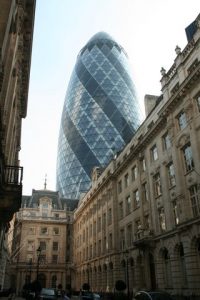Although the historic and modern medium density London is not visible from Bishops Square in this photograph, Foster thankfully has provided the city with a Landmark building which orientates us within a largely visually undifferentiated urban environment; and the green space and water garden provide the amenity so beloved of London’s inner city squares.
New York New York so good they named it twice
Red green vertical garden building
 This building is green in summer and red in autumn. It makes a useful contribution to re-balancing the carbon cycle, by absorbing CO2. Undesirable particulates (dust!) stick to leaves and are swept up in autumn. The leaves shield the building from undue solar gain in summer. Traffic noise is absorbed. Birds and insects find habitats amongst the vegetation. It is a beautiful building (Point House facing Blackheath in South London). Why can’t we have more facades treated like this? Call them vertical gardens if it would help. Co-ordinated planting on discordant buildings would harmonize argumentative buildings.
This building is green in summer and red in autumn. It makes a useful contribution to re-balancing the carbon cycle, by absorbing CO2. Undesirable particulates (dust!) stick to leaves and are swept up in autumn. The leaves shield the building from undue solar gain in summer. Traffic noise is absorbed. Birds and insects find habitats amongst the vegetation. It is a beautiful building (Point House facing Blackheath in South London). Why can’t we have more facades treated like this? Call them vertical gardens if it would help. Co-ordinated planting on discordant buildings would harmonize argumentative buildings.
London with a green roof
Thank you to Allen & Overy for opening their offices under the Open House scheme – and congratulations to them for having an office with genuinely green credentials. Roof space is used for solar panels, roof gardens or wildlife habitats (brown roofs). As the office brochure remarks ‘One of the best features of Bishops Square is the ability to hold barbecues in the summer or evening drinks on the terrace’. For me, it was a pleasure to see the City taking a small step towards the London equivalent of New York As it Should Be.
The City should designate its Square Mile as a Green Roof Zone.
Foreign and Commonwealth Office Garden
The HQ of the UK Foreign and Commonwealth Office is open this weekend as part of London’s Open House scheme. I came away with two ideas. First, they should treat the Durbar Court as an indoor garden for senior civil servants to tend. It would give them useful experience of the cultural differences between the UK and other countries. Second, they should commission a new building, with gardens inside, outside and on top. Sir George Gilbert Scott’s design, completed shortly after the ‘Indian Mutiny (aka India’s First War of Independence) could then become a Museum of Empire, dedicated to involving visitors in a discussion of the pros and cons of imperialism and globalization. Douglas Hurd, when he was Mrs Thatcher’s Foreign Secretary, used to say that Britain was a country which could ‘punch above its weight’. I wish we could either stop punching or learn to punch well below our weight. This would be a genuinely ethical foreign policy – and a lush display of semi-tropical plants in the Durbar Court would be a step in the right direction. The original design, by Digby Wyatt, had the Court open to the skies, which must have been cold. It is believed that it was glazed over to receive the Sultan of Turkey in 1867. The Durbar Court is now used for receptions and would be a softer and less imperious place if well planted.
Or should it remain unplanted in the interests of historical accuracy?
Roberto Burle Marx as a context-sensitive designer
As a painter, Roberto Burle Marx was an international abstract expressionist. But as a garden designer and landscape architect he showed a high degree of sensitivity to context – I say ‘surprising’ only because I was so slow to appreciate the complexity of this point. His planting was voluptuously Brazilian, like his mother, and Marx could see no reason for using European plants. Nor did he see any reason for the hard detailing to draw inspiration from the land of his father: Germany. Instead, he drew upon the country whose language is spoken in Brazil. The accompanying photograph is of Copacabana Beach – but could just as well have been taken in Portugal. Until I went to Portugal, I thought this amazing design was an example of Burle Marx inventiveness as an abstract painter. I was very wrong.





